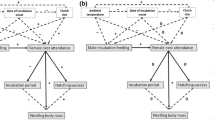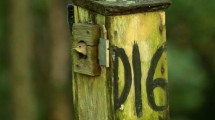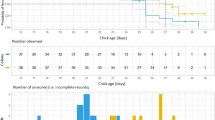Summary
Male snow buntings regularly feed their mates on the nest during the incubation period. We removed males from 7 females at the start of incubation (Early Widows) and from 7 others when the eggs hatched (Late Widows) to experimentally assess the effects of incubation feeding on the behaviour of females and the reproductive success of both parents. Early Widows spent significantly more time off their nests than Late Widows and Controls. As a consequence, Early Widows had significantly longer incubation periods and a significantly higher proportion of them lost two or more eggs during development. There was no difference between Early and Late Widows in any index of reproductive success measured during the nestling period although significantly earlier brood reduction suggests that Early Widows were in poorer condition than Late Widows. Since both parents benefitted from incubation feeding by increased hatching success and shorter incubation periods, we conclude that this behaviour is an adaptive form of indirect parental care by males and is not the result of female manipulation.
Similar content being viewed by others
References
Birkhead TR (1979) Mate guarding in the magpie (Pica pica). Anim Behav 27:866–874
Blagosklonov KN (1978) Experimental analysis of the rhythm of incubation in the pied flycatcher (Ficedula hypoleuca). Sov J Ecol 8:340–344 (translated from Ekologiya (1971) 4:66–71
East M (1981) Aspects of courtship and parental care in the European robin Erithacus rubecula. Ornis Scand 12:230–239
Emlen ST, Oring LW (1977) Ecology, sexual selection and the evolution of mating systems. Science 197:215–223
Haartman L von (1958) The incubation rhythm of the female pied flycatcher (Ficedula hypoleuca) in the precence and absence of the male. Ornis Fenn 35:71–76
Hussell DJT (1972) Factors affecting clutch size in arctic passerines. Ecol Monogr 42:317–364
Kendeigh SC (1952) Parental care and its evolution in birds. Ill Biol Monogr 22:1–357
Knowlton N (1979) Reproductive synchrony, parental investment and the evolutionary dynamics of sexual selection. Anim Behav 27:1022–1033
Lack D (1968) Ecological adaptations for breeding in birds. Methuen, London
Lundy H (1969) A review of the effects of temperature, humidity, turning and gaseous environment in the incubator on the hatchability of the hen's egg. In: Carter TC, Freeman BM (eds) The fertility and hatchability of the hen's egg. Oliver and Boyd, Edinburgh, pp 143–176
Lyon BE (1984) Why male snow buntings feed their mates: evolutionary and ecological considerations. MSc thesis, Queen's University, Kingston, Canada
Montgomerie RD, Cartar RV, McLaughlin RL, Lyon B (1983) Birds of Sarcpa Lake, Melville Peninsula, Northwest Territories: breeding phenologies, densities and biogeography. Arctic 36:65–75
Newton I (1979) Population ecology of raptors. Buteo, Vermillion, SD
Niebuhr V (1980) An investigation of courtship feeding in herring gulls Larus argentatus. Ibis 123:218–223
Nolan V Jr (1978) The ecology and behavior of the prairie warbler Dendroica discolor. Ornithol Monogr 26:1–195
Perrins CM (1965) Pipulation fluctuations and clutch size in the great tit Parus major L. J Anim Ecol 34:601–647
Ricklefs RE (1965) Brood reduction in the curve-billed thrasher. Condor 67:505–510
Ricklefs RE (1969) An analysis of nesting mortality in birds. Smithson Contrib Zool 9:1–48
Ricklefs RE (1974) Energetics of reproduction in birds. In: Paynter RA Jr (ed) Avian energetics. Publ Nuttall Ornithol Club 15:152–292
Ricklefs RE (1983) Avian postnatal development. In: Farner DS, King JR (eds) Avian biology, vol 7. Academic, New York, pp 1–83
Romanoff AL, Romanoff AJ (1972) Pathogenesis of the avian embryo. Wiley, New York
Roskaft E (1983) Sex role partitioning and parental care in the rook Corvus frugilegus. Ornis Scand 14:180–187
SAS Institute (1982) SAS user's guide: statistics. SAS Institute, Cary, NC
Skutch AF (1953) How the male discovers the nestlings. Ibis 95:1–37
Smith SM (1980) Demand behavior — a new interpretation of courtship feeding. Condor 82:291–295
Tinbergen N (1939) The behavior of the snow bunting in spring. Trans Linn Soc NY 5:1–94
Weatherhead PJ, Robertson RJ (1980) Altruism in the savannah sparrow. Behav Ecol Sociobiol 6:185–186
Author information
Authors and Affiliations
Rights and permissions
About this article
Cite this article
Lyon, B.E., Montgomerie, R.D. Incubation feeding in snow buntings: female manipulation or indirect male parental care?. Behav Ecol Sociobiol 17, 279–284 (1985). https://doi.org/10.1007/BF00300147
Received:
Accepted:
Issue Date:
DOI: https://doi.org/10.1007/BF00300147




